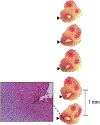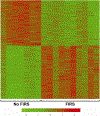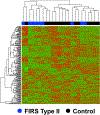The fetal inflammatory response syndrome: the origins of a concept, pathophysiology, diagnosis, and obstetrical implications
- PMID: 33164775
- PMCID: PMC10580248
- DOI: 10.1016/j.siny.2020.101146
The fetal inflammatory response syndrome: the origins of a concept, pathophysiology, diagnosis, and obstetrical implications
Abstract
The fetus can deploy a local or systemic inflammatory response when exposed to microorganisms or, alternatively, to non-infection-related stimuli (e.g., danger signals or alarmins). The term "Fetal Inflammatory Response Syndrome" (FIRS) was coined to describe a condition characterized by evidence of a systemic inflammatory response, frequently a result of the activation of the innate limb of the immune response. FIRS can be diagnosed by an increased concentration of umbilical cord plasma or serum acute phase reactants such as C-reactive protein or cytokines (e.g., interleukin-6). Pathologic evidence of a systemic fetal inflammatory response indicates the presence of funisitis or chorionic vasculitis. FIRS was first described in patients at risk for intraamniotic infection who presented preterm labor with intact membranes or preterm prelabor rupture of the membranes. However, FIRS can also be observed in patients with sterile intra-amniotic inflammation, alloimmunization (e.g., Rh disease), and active autoimmune disorders. Neonates born with FIRS have a higher rate of complications, such as early-onset neonatal sepsis, intraventricular hemorrhage, periventricular leukomalacia, and death, than those born without FIRS. Survivors are at risk for long-term sequelae that may include bronchopulmonary dysplasia, neurodevelopmental disorders, such as cerebral palsy, retinopathy of prematurity, and sensorineuronal hearing loss. Experimental FIRS can be induced by intra-amniotic administration of bacteria, microbial products (such as endotoxin), or inflammatory cytokines (such as interleukin-1), and animal models have provided important insights about the mechanisms responsible for multiple organ involvement and dysfunction. A systemic fetal inflammatory response is thought to be adaptive, but, on occasion, may become dysregulated whereby a fetal cytokine storm ensues and can lead to multiple organ dysfunction and even fetal death if delivery does not occur ("rescued by birth"). Thus, the onset of preterm labor in this context can be considered to have survival value. The evidence so far suggests that FIRS may compound the effects of immaturity and neonatal inflammation, thus increasing the risk of neonatal complications and long-term morbidity. Modulation of a dysregulated fetal inflammatory response by the administration of antimicrobial agents, anti-inflammatory agents, or cell-based therapy holds promise to reduce infant morbidity and mortality.
Keywords: Cerebral palsy; Chorioamnionitis; Congenital dermatitis; Cytokines; FIRS; Fetal cytokine release syndrome; Fetal cytokine storm; Fetal hematophagocytic syndrome; Fetal macrophage activation-like syndrome; Funisitis; Interleukin-6; Intra-amniotic infection; Intra-amniotic inflammation; Neonatal encephalopathy; Neonatal morbidity; Neonatal sepsis; Neuroinflammation perinatal morbidity; Premature birth; Prematurity; Preterm labor; Preterm prelabor rupture of the membranes (preterm PROM); Retinopathy of prematurity; Sensorineuronal hearing loss.
Published by Elsevier Ltd. This is an open access article under the CC BY-NC-ND license (http://creativecommons.org/licenses/by-nc-nd/4.0/).
Conflict of interest statement
Declaration of competing interest
The authors report no conflicts of interest.
Figures










Similar articles
-
Clinical chorioamnionitis at term V: umbilical cord plasma cytokine profile in the context of a systemic maternal inflammatory response.J Perinat Med. 2016 Jan;44(1):53-76. doi: 10.1515/jpm-2015-0121. J Perinat Med. 2016. PMID: 26360486 Free PMC article.
-
Acute chorioamnionitis and funisitis: definition, pathologic features, and clinical significance.Am J Obstet Gynecol. 2015 Oct;213(4 Suppl):S29-52. doi: 10.1016/j.ajog.2015.08.040. Am J Obstet Gynecol. 2015. PMID: 26428501 Free PMC article. Review.
-
Preterm labor and preterm premature rupture of membranes have a different pattern in the involved compartments of acute histologoic chorioamnionitis and/or funisitis: Patho-physiologic implication related to different clinical manifestations.Pathol Int. 2016 Jun;66(6):325-32. doi: 10.1111/pin.12412. Epub 2016 Apr 18. Pathol Int. 2016. PMID: 27090052
-
Soluble ST2 in the fetal inflammatory response syndrome: in vivo evidence of activation of the anti-inflammatory limb of the immune response.J Matern Fetal Neonatal Med. 2013 Sep;26(14):1384-93. doi: 10.3109/14767058.2013.784258. Epub 2013 Jun 25. J Matern Fetal Neonatal Med. 2013. PMID: 23488731 Free PMC article.
-
Clinical chorioamnionitis at term: definition, pathogenesis, microbiology, diagnosis, and treatment.Am J Obstet Gynecol. 2024 Mar;230(3S):S807-S840. doi: 10.1016/j.ajog.2023.02.002. Epub 2023 Mar 21. Am J Obstet Gynecol. 2024. PMID: 38233317 Review.
Cited by
-
Leveraging transcriptomics to develop bronchopulmonary dysplasia endotypes: a concept paper.Respir Res. 2023 Nov 15;24(1):284. doi: 10.1186/s12931-023-02596-y. Respir Res. 2023. PMID: 37968635 Free PMC article.
-
[Clinical characteristics of Ureaplasma urealyticum infection and colonization in extremely preterm infants].Zhongguo Dang Dai Er Ke Za Zhi. 2024 Aug 15;26(8):811-816. doi: 10.7499/j.issn.1008-8830.2403002. Zhongguo Dang Dai Er Ke Za Zhi. 2024. PMID: 39148384 Free PMC article. Chinese.
-
Understanding Host-Pathogen Interactions in Acute Chorioamnionitis Through the Use of Animal Models.Front Cell Infect Microbiol. 2021 Jul 27;11:709309. doi: 10.3389/fcimb.2021.709309. eCollection 2021. Front Cell Infect Microbiol. 2021. PMID: 34386434 Free PMC article. Review.
-
Viral infections in pregnancy and impact on offspring neurodevelopment: mechanisms and lessons learned.Pediatr Res. 2024 Jul;96(1):64-72. doi: 10.1038/s41390-024-03145-z. Epub 2024 Mar 20. Pediatr Res. 2024. PMID: 38509227 Review.
-
Fetal origin of bronchopulmonary dysplasia: contribution of intrauterine inflammation.Mol Med. 2024 Sep 3;30(1):135. doi: 10.1186/s10020-024-00909-5. Mol Med. 2024. PMID: 39227783 Free PMC article. Review.
References
-
- Wendel GD Jr, Sanchez PJ, Peters MT, Harstad TW, Potter LL, Norgard MV. Identification of Treponema pallidum in amniotic fluid and fetal blood from pregnancies complicated by congenital syphilis. Obstet Gynecol 1991;78(5 Pt 2): 890–5. - PubMed
-
- Morgan-Capner P, Rodeck C, Nicolaides K, Cradock-Watson J. Prenatal detection of rubella-specific IgM in fetal sera. Prenat Diagn 1985;5(1):21–6. - PubMed
-
- Thilaganathan B, Carroll SG, Plachouras N, Makrydimas G, Nicolaides KH. Fetal immunological and haematological changes in intrauterine infection. Br J Obstet Gynaecol 1994;101(5):418–21. - PubMed
-
- Donders GG, Moerman P, Caudron J, Van Assche FA. Intra-uterine Candida infection: a report of four infected fetusses from two mothers. Eur J Obstet Gynecol Reprod Biol 1991;38(3):233–8. - PubMed
-
- Carroll SG, Nicolaides KH. Fetal haematological response to intra-uterine infection in preterm prelabour amniorrhexis. Fetal Diagn Ther 1995;10(5): 279–85. - PubMed
Publication types
MeSH terms
Substances
Grants and funding
LinkOut - more resources
Full Text Sources
Medical
Research Materials

